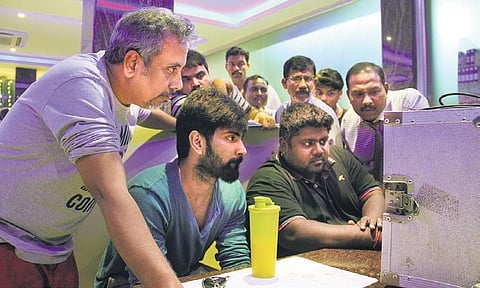

When did you realise cinema was your calling?
While studying BCom, I had no idea what I was going to do next. I loved watching films, especially those of Balu Mahendra sir and Balachander sir. I found them inspiring. That’s when I read Vaanga Cinemavai Patri Pesalam by K Bhagyaraj sir, in a library.
Reading it increased my interest in cinema. I also realised that no one can get into the industry without going through the works of Bhagyaraj sir. I watched all his films, learning many things such as screenplay patterns. I started with ad films, and to learn the craft, I enrolled in a DFT (Diploma in Film Technology) course.
What have you learned from your directors?
Badri Venkatesh, thanks to assisting KS Ravikumar sir, works at a breakneck speed. If he expects to start work at 5 am, he would be there by 4:30 am itself. I learnt from him that quantity is more important than quality at times. He would say it’s impossible to get 100 per cent every time and we cannot sabotage an entire day for perfecting a scene.
He makes sure that the schedule given to the producer is followed to the T Dhana sir knows how to tackle a multi-starrer like Vaanam Kottattum. Not to mention that handling a Mani sir script is a dream for many ADs.
Krishna Vamsi does not believe in having everything written down. He would have the one line for the scene in his mind for that day and that spontaneity is mind-blowing. It also means that we have to run around to get what’s needed for the scene at the last minute but that’s how we learnt a lot of things.
What’s the oddest or most memorable thing you have seen or done as an AD?
I was in charge of continuity for a certain scene once, and this well-established character artist used the phone on her left hand for one scene, and on her right for the next. So, I stopped the shot. She got offended and argued for about 30 minutes that she had it on her right hand the entire time.
The director told her that I had a written record saying otherwise, but she would not budge. Though I was scared, I was confident that I was right. Finally, they replayed the scene and thankfully, I was. Such arguments during continuity checks are quite common though.
What’s one area of filmmaking you had a tough time with, but are better at now?
When translating a scene from the paper to the screen, some things have to be added to bring in the soul of that scene. Films like those of Balu Mahendra and Balachander look authentic mainly because of this.
Instead of having a character stand still in a scene, giving them an activitywhile mouthing the lines adds authenticity. In Guna, for example, Kamal sir drives a car up the hill. Before getting off the car, he pauses a second to engage the hand brake. That authenticity makes a huge difference to a scene. Incorporating this idea into writing was initially hard, but I’ve learnt it.
What is your take on present-day cinema?
When I graduated in the early 2000s, a lot of theatres were refurbished into marriage halls and that’s the reason many of us started with television programs and ads. We thought that the industry is nearly dead. But when digital came in, it was a game changer. We had directors like Karthik Subbaraj and Nalan Kumarasamy come in, along with many others who only had short films as their resume. We’re still reaping those benefits.
Who would be the dream cast and/or crew for your debut project?
Vetri of 8 Thottakkal and Jiivi fame has been a close friend of mine for a few years. I have discussed a script with him which we have wanted to do for a while now. So it would probably be him.